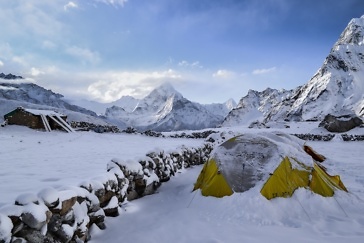 When we woke at 2:30 a.m., the tent seemed smaller than it had when we crawled in to sleep a few hours earlier. It had begun to snow and the walls were caving in. For the rest of the night, we thumped the nylon periodically to keep the snow from accumulating and collapsing the tent. We were sleepless, but not too worried. Wilderness back packing is something my wife Maghi and I have been doing for years.
When we woke at 2:30 a.m., the tent seemed smaller than it had when we crawled in to sleep a few hours earlier. It had begun to snow and the walls were caving in. For the rest of the night, we thumped the nylon periodically to keep the snow from accumulating and collapsing the tent. We were sleepless, but not too worried. Wilderness back packing is something my wife Maghi and I have been doing for years.
We were camped by a lake 10,500 feet up in the Wind River Mountains of Wyoming, miles from everywhere. It had taken three days of hard walking to get there, through some steep rockslides with boulders as big as houses. Rain and sleet on the way up had made hiking difficult, snow would make going down that way impossible. It was too early for snow, but the storm hadn’t read the almanac.
Our plan was to make a loop—to stay one night at this lake then hike over the pass another thousand feet above us. The way up from here was a poorly marked switchback trail, impossible to discern now in the snow.
To make things worse, both of us had come down with sinus infections. We had a good medical kit and started right in with antibiotics. Still, we spent a miserable three nights and two days in the tent in the snow, trying to find in our trail mix and freeze-dried foods something that wasn’t too hard for our inflamed throats to swallow.
I spent a lot of time looking through binoculars at the route to the pass, hoping to find enough landmarks to take us safely across. There wasn’t much to see. Snow makes everything really quiet, and in three days, camped right by the trail, we neither saw nor heard another human being.
We were praying a lot to Babaji, the ever-living himalayan yogi, figuring he was the one who could help us out of this jam. Finally there was a small break in the weather. Snow still covered the switchback trail, but we knew we had to get out of there and the pass was the only way. Shortly after we started walking, we saw booted footprints on the trail going just the direction we wanted to go.
Everybody these days, going through such rough terrain, uses hiking poles. But there was no sign of poles, just footprints. They continued all the way up the switchback, which would have been impossible to find without the prints to guide us. At one point they led us off the main trail to a little lake, then they came back again and continued up toward the pass.
About halfway to the top we stopped to rest against a large rock. Close to the ground there was an overhang sheltering a small grassy area untouched by snow. Maghi leaned over and underneath saw what looked like a little grass-carpeted natural chapel, complete with a discolored marking on the back “wall” in the shape of an arch, just the right size for a wallet-size picture of Babaji. We imagined him sitting there in his tiny rock chapel and prayed for his blessing.
We reached the pass and started down the other side. The snow was a little thinner here, and not too far ahead we could see the trail down. At that point the footprints turned to the right. We weren’t depending on them now, and they were going where we didn’t want to go, but of course, we followed, hoping to catch up with our mysterious benefactor. The footprints led to a large boulder in the middle of a smooth, snow-covered field. There they stopped.
—from Vasanta
